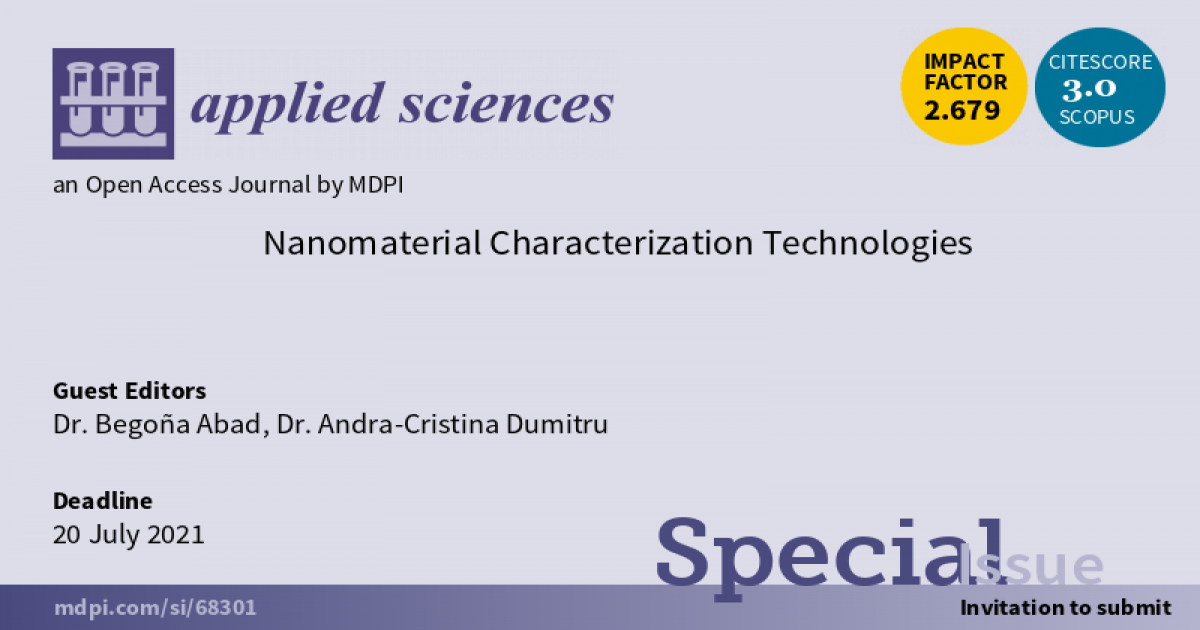Nanomaterial Characterization Technologies
A special issue of Applied Sciences (ISSN 2076-3417). This special issue belongs to the section "Nanotechnology and Applied Nanosciences".
Deadline for manuscript submissions: closed (20 July 2021) | Viewed by 7214

Special Issue Editors
Interests: nanoscale heat transport; phonon dynamics; pump–probe spectroscopy; advanced Raman spectroscopies; ultrafast lasers; acoustic dynamics; nanomaterials
Interests: atomic force microscopy; multifunctional imaging techniques; single-molecule and single-cell biophysics; soft matter mechanics; plasma membrane organization; membrane proteins
Special Issue Information
Dear Colleagues,
Technological innovations are continously changing the nanomaterials field, and sophisticated nanofabrication techniques are currently able to synthesize features down to the atomic level. Complex metrogolgy and characterization techniques are required to understand the fundamental properties of these new material systems, as new unique phenomena emerge from the reduction of the characteristic length scales. Applications are ubiquitous, spanning energy transport, electronics and photonics, nanobiotechnology, nanosensors and other devices, molecular interactions, soft matter mechanics, molecular physics, and quantum chemistry.
In this Special Issue, we invite submissions exploring the development of nanoscale characterization tools, as well as new fundamental insights into the structure and behavior of materials at the nanoscale, for advancing technological and biomedical applications. Contributions can focus on metrology techniques, transport properties, mechanical properties, physicochemical properties, magnetic transport, spintronics, optical and force nanoscopy, biomaterials, polymers and nanostructured surfaces, and single-molecule biophysics. Survey papers and reviews are also welcome.
Dr. Begoña AbadDr. Andra-Cristina Dumitru
Guest Editors
Manuscript Submission Information
Manuscripts should be submitted online at www.mdpi.com by registering and logging in to this website. Once you are registered, click here to go to the submission form. Manuscripts can be submitted until the deadline. All submissions that pass pre-check are peer-reviewed. Accepted papers will be published continuously in the journal (as soon as accepted) and will be listed together on the special issue website. Research articles, review articles as well as short communications are invited. For planned papers, a title and short abstract (about 100 words) can be sent to the Editorial Office for announcement on this website.
Submitted manuscripts should not have been published previously, nor be under consideration for publication elsewhere (except conference proceedings papers). All manuscripts are thoroughly refereed through a single-blind peer-review process. A guide for authors and other relevant information for submission of manuscripts is available on the Instructions for Authors page. Applied Sciences is an international peer-reviewed open access semimonthly journal published by MDPI.
Please visit the Instructions for Authors page before submitting a manuscript. The Article Processing Charge (APC) for publication in this open access journal is 2400 CHF (Swiss Francs). Submitted papers should be well formatted and use good English. Authors may use MDPI's English editing service prior to publication or during author revisions.
Keywords
- Nanomaterials
- Nanostructures
- Nanoscale metrology
- Nanoscale properties
- Nanoscale applications
- Characterization
- Energy transport
- Thermoelectric characterization
- Magnetic transport
- Biocharacterization
- Spectroscopy
- Atomic force spectroscopy
Benefits of Publishing in a Special Issue
- Ease of navigation: Grouping papers by topic helps scholars navigate broad scope journals more efficiently.
- Greater discoverability: Special Issues support the reach and impact of scientific research. Articles in Special Issues are more discoverable and cited more frequently.
- Expansion of research network: Special Issues facilitate connections among authors, fostering scientific collaborations.
- External promotion: Articles in Special Issues are often promoted through the journal's social media, increasing their visibility.
- Reprint: MDPI Books provides the opportunity to republish successful Special Issues in book format, both online and in print.
Further information on MDPI's Special Issue policies can be found here.






